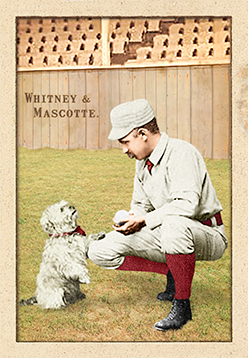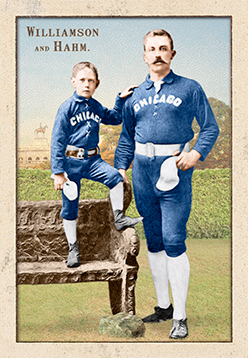- Series: 1880s: Diamond Duos
- City: New York
- Team: Giants
- League: National League
Art Whitney:
Arthur Wilson Whitney (1858-1943). Art played 3rd base for 8 different teams over 11 major league seasons. A below average hitter, his best year may have been 1886 with the Pittsburgh Alleghenys when he compiled 122 hits, 13 doubles, 4 triples, 15 steals & 70 runs with a light .239 batting average.
- 2x World Series Champion with the New York Giants: 1888 & 1889
- Although I haven't quite figured it all out, it appears Whitney was part of a fairly distinguished baseball family. His brother Frank played for the Boston Red Stockings in 1876; Charles Whitney, who played minor league ball from 1879 to 1889, was also likely Art's brother; and research suggests that 10 year major league veteran Grasshopper Jim Whitney may have been a cousin.
Mascotte:
This dog's name and relationship to Art Whitney and/or the New York Giants has been lost to history. I have no evidence that this dog ever served as the team's mascot, but she does appear to be wearing a handkerchief in the team's colors. The Giants (Buck Ewing in particular) were notoriously superstitious about their mascots. At one time or another between 1884 and 1890, the Giants "employed" at least five children: Masters Boldt, Bretsie, Preston, Breslin and an unidentified "colored boy," a yellow mongrel dog who was eventually captured by animal control and euthanized, and a toy rubber dog that barked when squeezed.
Despite the mystery surrounding this dog, her presence and photogenic posing created what REA has described as "one of the most unusual and memorable images to ever appear on a baseball card." It has been suggested that this image was staged and intended by the Goodwin photographers to represent a sort of comedic complex irony. Between the minor and major leagues, Art Whitney played for 12 different teams over 17 professional seasons and twice sued his team in contractual disputes. Even in an era when few players stayed with any one team for more than a year or two, Whitney's lack of loyalty was possibly renowned and cast into stark contrast in this photo by the adoring attention he is being given by man's best friend, the ever-loyal dog.
Whether the meeting between the two was devised or a genuine moment in time caught by a Goodwin photographer, I think the image's appeal is due to something simple we can all relate to: it's fun.
In fact, this is perhaps the image that most directly inspired the idea behind the Ars Longa 1880s series. In the nascent stages of my work, when this was all but an amorphous and rudimentary idea, I saw this image and thought how fun it would be to colorize it. Three and a half years and nearly 750 cards later, here it is.

